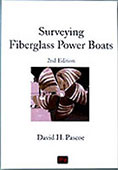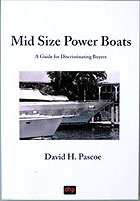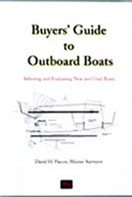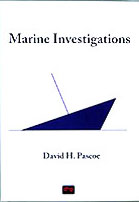Addendum to:
The EL TORO II Tragedy:
Sinking of Party Fishing Vessel "EL TORO II"
An Independent Review of the Coast Guard Investigation Report
by David Pascoe
It has since been learned that the survivors of at least one of the victims in the EL TORO incident has filed suit in excess of $10 million against Insurance Company Of North America, their staff surveyor and the vessel owner, Chesapeake Bay Fishing Parties, Inc.
Related Reading:
The EL TORO II TragedySinking of Party Fishing Vessel
An independent Review of USCG Investigation Report
EL TORO II: The NTSB Report
How to Survey A Wood Hull
Attorneys on behalf of INA and the surveyor had filed a motion for summary judgment for dismissal which was recently denied by the trial judge. The basis for that denial should be of interest to surveyors.
The plaintiff claims that INA and the surveyor (personally) were negligent for their failure to notify the vessel owner of the results of the survey, and that they could have, and should have, placed the vessel on port risk. Whether there was an existing policy on EL TORO was not clear, but the information available indicates that INA insured the four other vessels owned by Chesapeake so presumably they insured the entire fleet.
According to court documents, the surveyor's report stated "This may be the worst Coast Guard inspected boat I have seen. In it's current condition, I do not consider it suitable for operation or carriage of passengers."
That's pretty heavy language but it did not save him from being sued. While defendant INA and the surveyor claimed that they could not be negligent because there existed no duty to the plaintiffs, plaintiffs argued that INA and it's surveyor had a special relationship with the vessel owner which burdened them with the duty to notify the results of the survey.
Since the accident occurred only 5 days after the survey, its entirely possible that the surveyor had not even completed his written report as of that time. But the court ruled that there was enough of a factual dispute on these claims as grounds for denial of the summary judgment.
Remember here that the plaintiffs are a third party, the survivors of the deceased. The claim of a special duty comes from not merely from the vessel owner, but the passengers. So what its saying then, is that the surveyor's duty is not limited to the vessel owner, but that that duty can extend to anyone in, on or around that vessel.
This ruling should be particularly troubling to surveyors. The effect of it is to suggest that the surveyor may have a duty, and that the notification should be immediate. This tragedy occurred 5 days after the survey, but could just as easily have occurred 5 hours after the survey. Its not unusual for a commercial vessel to leave the dock only minutes or a few hours after the surveyor completes his work. There have been numerous times when this writer performed surveys in only a couple hours between trips. With fishing and ferry vessels, this is more often the case than not.
This demand places an untenable burden on the surveyor for it leaves him no time for research or reflection on his findings. It suggests that in very gray legal world, the surveyor is required to see everything in black and white, that he should make snap decisions with no time for consideration or reflection, yet alone the time to compose a written report.
The surveyor now gets it from both sides. The judge is saying that the surveyor may be liable for not making an immediate notification. On the other hand, if the surveyor has to condemn the vessel on a snap decision, and should he be in any way wrong - remembering that he is given no time for consideration - then surely the owner will sue him for being in error and costing the vessel owner a loss of revenue, among many other damages real or imagined.
As an example of how this might work, let's say that the owner told the surveyor that the vessel was bronze fastened, and was refastened 8 years ago. But knowing the builder of the vessel, the surveyor believes that it is fastened with steel nails. With the vessel being afloat, he has no way to check this, and otherwise finds no indication of a hull problem. However, he knows that if the owner is mistaken, or not telling him the truth, a 30 year old wooden vessel that is fastened with nails is highly unlikely to be seaworthy. In order to complete his survey, the surveyor needs to contact the builder (if still in business) or do some other kind of research to attempt to verify the owner's claims. It may take him several days to complete this research.
In the meantime, the vessel goes to sea and is lost and the surveyor is now in the hot seat. The INA surveyor probably would have been wise to frame his defense in this manner, in essence stating that the survey was not complete. Whether it was or not, we don't know, nor would anyone have known had the surveyor given notice that his work was not complete.
This sort of catch 22 is not limited to commercial vessels and has been known to happen with yachts being used solely for pleasure. A number of cases have arisen where there were ongoing repairs while the survey was being done, repairs involving a condition that would cause unseaworthiness. The surveyor either assumed that because it was being worked on, or because the owner assured the surveyor that a condition would be corrected, the surveyor omitted that situation from his report. And once having made the fatal assumption, of course the problem was not fully corrected and resulted in a serious casualty for which the surveyor was later blamed.
As most surveyors know, whether you're right or wrong is ultimately irrelevant in the face of a major lawsuit. A defense of this magnitude would bankrupt the surveyor even in the initial stages, yet alone a case involving multiple plaintiffs and defendants that drags on for years. And in the EL TORO case, the surveyor is a direct employee of the insurer, and yet he is not immune to being sued personally.
So, is there a way out? Fortunately there is. Should such a situation arise upon the completion of a survey, whether of a pleasure craft or passenger vessel, the answer is for the surveyor to advise the vessel owner both verbally and in writing. He does not have to state that there are defacto defects that absolutely cause unseaworthiness when he is unsure about that. Instead, he can advise the owner that there MAY be defects that cause unseaworthiness, and that these defects require research before the surveyor can render his final judgment. Even if the vessel leaves the dock 5 minutes after he steps off the vessel, he should give that verbal notice and follow up with it in writing the very same day, even if he has to hire a courier to do so.
The point is to toss the ball back to the vessel owner. It's his boat, and he's the one who should be responsible for ensuring its seaworthiness, not the surveyor. But when the surveyor steps into the picture, that burden begins to shift if he has special knowledge of unseaworthiness. If the surveyor has that special knowledge, but does not communicate it to the vessel owner, then he may be complicit.
When the verbal advice is given, the surveyor should try to do it in a situation where there are witnesses. Then he should record the moment on his survey notes including the day an hour. Better yet, try to get owner or captain to sign a short statement saying that they have been notified of potential problems. It's your life and livelihood at stake, so don't be shy about it.
Situations like these again point up the truth that the surveyor can't ever take too many photographs. Here's another neat little trick of the trade that only experience can teach. Physically lead the vessel owner to the problem at hand and ask him to point to it while you take his picture pointing to it. Unless he can prove that you have a doctored photo (yes, be sure to staple those negatives to the file!!!), there's no way that he can deny that you not only told him, but actually showed him. If you suspect a serious problem, find somebody involved with the vessel and find a way to work them into the photograph, even if he's not willing to assist you in protecting yourself. Do that and you've now got the best liability insurance you could ever get at the cost of a photograph. This insurance doesn't just defend you, rather it protects you from being sued in the first place.
Then, if a suit should suddenly appear out of the blue, all you have to do is send the lawyer a copy of your pictures and threaten to counter sue. I've done this many times. It works! On one occasion I received suit papers alleging that I failed to inform a boat buyer that the fuel tanks were corroded, tanks which sprung leaks shortly after the survey. The allegation was that I had not explained the seriousness of the problem clearly. Not only was it mentioned in the report, but I also had a photo of the client pointing to the corroded spot near the tank bottom. The boat owner didn't bother to tell his lawyer that. Instead, he gave the lawyer the original report minus the photos. In this case, the boat owner was even willing to deceive his attorney. When I sent the lawyer the photos, the suit was dropped.
The real protection comes about when the vessel owner remembers that you took his picture and that you have proof that you physically showed him. My man with the corroded fuel tanks apparently forgot, but it was no trouble to refresh his memory.
Passenger carrying vessels pose enormous risk for independent surveyors. The risk is just as bad whether its a 35 foot dive boat or a 100 foot ferry boat. One death is not much of a bigger nightmare than a hundred deaths. The best protection that any surveyor can get is to simply not to involve himself with old vessels. But even if the vessel is new, passenger vessels call for extraordinary caution. The large car ferry that sank in the Baltic two years ago was nearly new and yet took several hundred people to the bottom. It will also take down everyone involved with it, innocent or not.
By the time a surveyor reaches the point in his career where he has surveyed a thousand or more vessels, the odds become heavily stacked against him that a vessel that he has surveyed will meet with tragedy. By the time it reaches two thousand, it is inevitable. By three thousand its likely to happen a dozen times. And that calls for a strategy of self-preservation. If he doesn't have one, the best advice is to get one.
Related Articles:
- The ELTORO Tragedy
Sinking of Party Fishing Vessel
An independent Review of USCG Investigation Report - EL TORO II: The NTSB Report
- How to Survey A Wood Hull
 Visit davidpascoe.com for his power boat books
Visit davidpascoe.com for his power boat books 















David Pascoe is a second generation marine surveyor in his family who began his surveying career at age 16 as an apprentice in 1965 as the era of wooden boats was drawing to a close.
Certified by the National Association of Marine Surveyors in 1972, he has conducted over 5,000 pre purchase surveys in addition to having conducted hundreds of boating accident investigations, including fires, sinkings, hull failures and machinery failure analysis.
Over forty years of knowledge and experience are brought to bear in following books. David Pascoe is the author of:
In addition to readers in the United States, boaters and boat industry professionals worldwide from nearly 80 countries have purchased David Pascoe's books, since introduction of his first book in 2001.
In 2012, David Pascoe has retired from marine surveying business at age 65.
On November 23rd, 2018, David Pascoe has passed away at age 71.
Biography - Long version